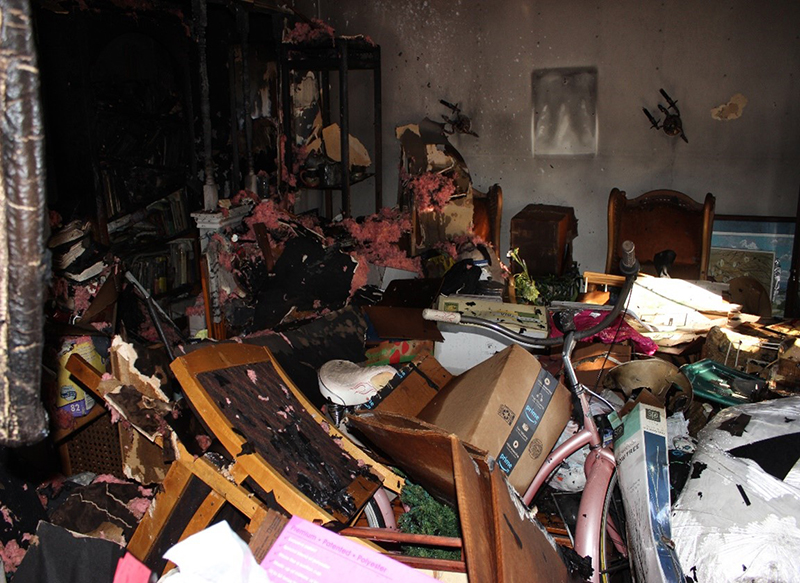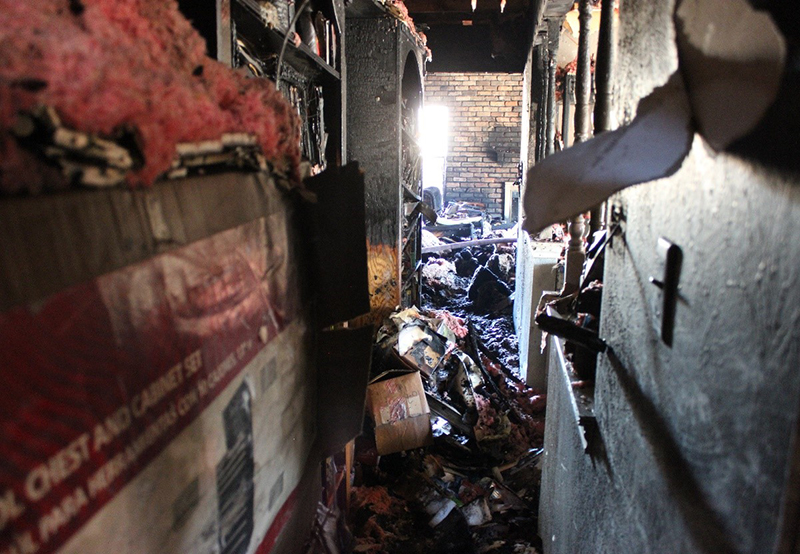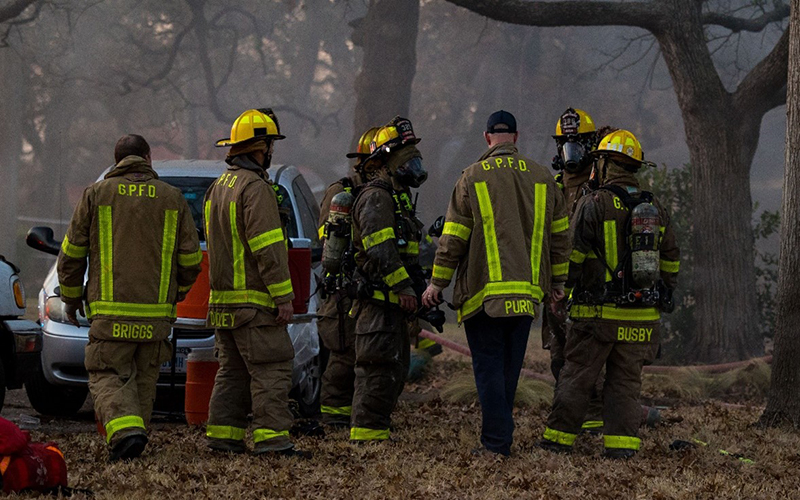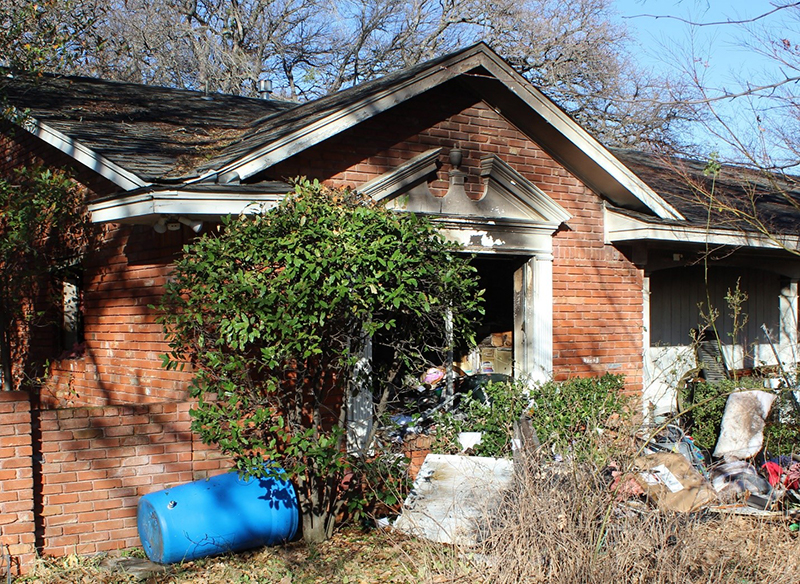WHAT WE LEARNED ❘ By James Purdom
The morning of January 12, 2023, was nice and cool in Grand Prairie, Texas. The temperature was 47°F and the wind was out of the West/Northwest at 10 to 15 miles per hour. The Grand Prairie Fire Department works a 48/96 schedule, and this was the morning of the second day of the tour for C shift.
- Hoarding: A Fire Prevention and Response Concern
- Drill of the Week: Disorientation Drill
- Hoarder Homes: Considerations for Fighting Fires in High Content/Reduced Air Space Homes
Setting the Scene
At 0633 hours, Grand Prairie Dispatch received a 911 call from the resident at 2345 Vega Street, stating that his house was on fire. The call taker advised him to exit the house but the caller was trying to get his dogs out. He stopped responding to the call taker. This information was in the call notes but was not stated over the radio.
The house was a 3,500-square-foot ranch-style structure, built in 1970. Looking at the A side of the house, the front door was in the center. Living areas were on the D side and bedrooms were on the B side. The garage was located on the D/C corner. The kitchen/dining area was on the C side straight through the front door. The rear door was at the back of the dining area and slightly offset to the D side of the front door. The utility room was to the D side of the rear door and led to the garage.
The Response
A one-alarm assignment consisting of Engine 4, Engine 1, Engine 3, Truck 8, Truck 1, Medic 4, Air 1, Battalion 1, and Battalion 2 was dispatched. Staffing consisted of three on engines, four on trucks, two on a medic, and a battalion chief and command captain (command tech) on the battalion chief units. Engine 4 arrived on scene at 0640 and advised there was a light haze in the street, performing a 360º size-up. All other units, except Battalion 2, arrived within four minutes of Engine 4. Lieutenant 4 advised that there was heavy smoke pushing from the rear of the house, the fire was possibly in the center of the house, and he did not see the resident. So this was likely a rescue. When Lieutenant 4 announced the likely rescue, command requested a second medic unit.

(1) A Google Map view of the house. (Photo courtesy of Google.)

(2) One of the small living areas. This is a good example of the condition of the house. (Photos by author unless otherwise noted.)

(3) The hallway leading to the B side and bedrooms.

(4) The hallway leading to the living rooms and fire rooms. I was unable to fit through with an SCBA on after the fire.
While Lieutenant 4 was performing the 360, Engine 4 firefighter stretched a 1¾-inch preconnect to the front door. Medic 4 joined Engine 4 to advance the initial attack line. Truck 8 split its crew and Truck 8A, consisting of Captain 8 and firefighter A, forced the door. Truck 8B, consisting of Driver 8 and firefighter B, did a quick exterior lap of the house and then entered to assist with search after the other crews had entered. Engine 1 secured a water supply and then assumed RIT, while Engine 3 pulled a second 1¾-inch hoseline to the front door. Battalion 1 assumed command and established the command post on the A/D corner. Truck 1 was assigned ventilation and went to the roof to cut a ventilation hole.
On entering, Engine 4 went straight ahead looking for the fire, Truck 8A went to the B side to search the bedrooms, and Engine 3 went to the intersection of the hallways/kitchen area to cover Truck 8A and look for fire. Truck 8B went to the B side to assist Truck 8A with search.

(5) The kitchen, next to the utility room where the victim was located.

(6) Front yard meeting after the Mayday was cleared. (Photo by Marina Bustillo.)

(7) A/B corner. This is an exterior view of the window Truck 8B firefighters exited.

(8) Interior view of the room and window that the Truck 8B firefighters exited.
Conditions Throughout the Home
As soon as they entered, crews encountered heavy hoarding conditions. Lieutenant 3 announced there was heavy smoke, medium heat, and hoarder conditions. All units later said they were unable to get below the smoke because when they tried to crawl, piles of debris fell on them. This made it difficult to move and was very disorienting.
The entry hall had half walls with small living areas on either side. But, due to the number of items stacked from the floor to the ceiling, everyone thought these were full walls. It wasn’t until after the fire was knocked down that the half walls were discovered. The fire was in the main living area on the D side, but because of the extremely narrow hallway, crews did not see the hallway until much later in the event.
Engine 4’s firefighter advanced down the entry hall, through the kitchen, past the rear door, and into the laundry room looking for the fire. Shortly after entering the laundry room, he located the victim, who was slumped on the washing machine. He called for assistance and the crew of Engine 3, who were in the kitchen, came to assist him with victim removal.
Lieutenant 1 was performing his 360 for RIT when Lieutenant 3 called for a crew at the back door to assist with victim removal. Firefighter 4 and Lieutenant 1 assisted the victim to the B side where the rest of Engine 1 crew and Medic 1 crew met them and began patient care. Medic 1 provided advanced life support and administered a cyanide poisoning kit. They transported the patient to Parkland Memorial Hospital where he stayed for a little more than a month before being released to rehab.
Engine 3 went back to staff their line after passing the victim to Lieutenant 1. Firefighter 4 rejoined his crew at the front entryway. Battalion 2 arrived on scene and was assigned Safety. Both crews from Truck 8 continued trying to search the bedrooms, while Engine 4 rescued a dog from another area of the house.
Truck 1 completed the ventilation hole in the center of the house on the A side of the ridgeline. Engine 3 crew later stated that visibility improved in the kitchen for a short time after the ventilation hole was cut, allowing them to reorient to the location of the exits; however, visibility quickly dropped again as they were still unable to locate the fire. At some point during this time, a window was broken on the B side but the room was not isolated. Lieutenant 1 announced that the victim told them he was the only person in the house and Engine 1 then reassumed RIT.
Fire began to extend down the hall from the living room and Engine 3 began flowing water. Lieutenant 3 announced water on the fire. When Engine 3 began flowing, the ceiling in the B side hallway fell. This happened just as Truck 8B was coming out of a bedroom, causing them to become disoriented and reenter the bedroom. E3 was hitting the fire as it extended down the hallway but was not getting to the seat of the fire. From the exterior, fire could be seen in the small living area just inside the front door, but Engine 3 could not see this fire or get water on it.
Lieutenant 3’s low-air alarm began to sound and he announced they were exiting for air. With the fire continuing to grow, command ordered all units to exit the house and ordered the officers to meet in the front yard to regroup and reset.
Truck 8B found their way out of the bedroom and into the hallway just before the order to exit was given, but as they advanced down the hallway, the fire began to extend toward them. They retreated into another bedroom and stated, “We can’t get out,” over the radio. Command acknowledged their transmission and called a Mayday. Command then asked their location and they replied, “We’re in a bedroom.”
Final Steps
RIT was activated and Safety requested Truck 8B activate their PASS alarms. Truck 8B activated their PASS alarms and Safety immediately announced that he had located them inside the window of the A/B bedroom. That window was taken out and the crew quickly exited. As T8B was exiting the window, RIT was ordered out of the house. All units exited the house and were accounted for. The Mayday was called at 0701 hours and all units were safely out without injury at 0704 hours.
Then exterior lines were used to control the fire. Truck 1 removed the gable from the D side and flowed a master stream into the attic for less than 30 seconds, knocking down the bulk of the fire. Multiple units were called to the scene to replace the original units. Replacement crews were able to reenter the house for final extinguishment, overhaul, and investigation. The last fire department crew cleared the scene at 1324 hours.

(9) Fire extension after all units were out of the house. (Photo by Marina Bustillo.)

(10) The command post meeting with relief units. (Photo by Marina Bustillo.)

(11) Truck 1 flowing into the D side gable. This quickly knocked down the bulk of the fire. (Photo by Marina Bustillo.)
Lessons Learned
This was a very challenging fire that reinforced old lessons and taught us new ones as well.
- Refer to call notes. If you have call notes available, read them. In this case, crews read the notes and knew this was likely a rescue. We should treat all fires as if there are occupants trapped; however, a known rescue may change the preassigned arrival duties. In this case, all units arrived in rapid order and preassignments did not change.
- Have preassignments in place. Preassignments make the first few minutes of an incident run smoothly. As units arrived on scene, crews knew their jobs and immediately went to work. This made the first few minutes go smoothly and cut down on radio traffic.
- Be ready to call for another ambulance. At the first indication of a victim, call for another ambulance. Medic 4 was actively involved in fire attack and was not in a good position to provide care and transport. By calling for Medic 1 early, they were immediately able to take over patient care. This provided for a smooth transition of the victim without affecting firefighting resources.
- Adjust as needed for hoarder conditions. Hoarder conditions raise the difficulty level significantly. Crews had difficulty moving because of the clutter. They were unable to get under the smoke because of all the debris falling on them. They missed the hallway to the fire room because it was so narrow. The bedrooms were difficult to search because of the volume of clutter. Crew accountability and communication must tighten up under these conditions because it is so easy to get disoriented.
- Manage ventilation. Control and management of ventilation are critical. Throughout this incident, the rear door was open. The front door was open from the time of our entry, a window was broken on the B side, and a vertical vent hole was made. With all these openings, the fire had multiple flow paths and all the oxygen it needed to continue to grow. If water isn’t applied to the seat of the fire quickly, it will grow exponentially, as it did in this case.
- The Truck 8B crew stated afterward that they didn’t call a Mayday because they didn’t feel like they were in that much danger. In this case, they quickly escaped, but it could have been much worse. It’s better to call early and get resources moving than it is to wait too long and potentially be too late.
- Command sets the tone for the incident. If command is calm, everyone else tends to stay calm. At this incident, command stayed calm throughout. Afterward, crews remarked that this was very reassuring and helped maintain that calm attitude across the board. The Mayday crew also remained calm, which allowed them to clearly communicate their situation, leading to a quick and safe resolution of the Mayday. Staying calm also allowed them to conserve air at a time when air usage could have been critical.
This was a very challenging incident from the beginning. The obstacles we had to overcome were significant: a caller who stayed inside his burning house, hoarder conditions inside, and a Mayday. This was an incident that could have had a much different and worse outcome. The professionalism and hard work of the members of the Grand Prairie Fire Department led to a successful rescue, a quickly and safely resolved Mayday, and a stop on the fire with the bulk of the house intact.
We plan to use the lessons learned at this fire and apply them to future fires to create a more efficient and safer fireground. We share this information and lessons learned in the hope that you can also learn from our experiences and use them to improve your operations.
JAMES PURDOM has been in the fire service for 25 years, the past 18 of those with the Grand Prairie Fire Department (GPFD), where he holds the rank of captain. He is a member of the GPFD instructor cadre, a lead instructor for the Weatherford College Fire and EMS academies, and a member of the Frontier F.O.O.L.S. He is a licensed paramedic, master firefighter, and instructor III and has numerous other certifications. Purdom has an associate of applied science degree from Weatherford College and a bachelor’s degree from West Texas A&M.

